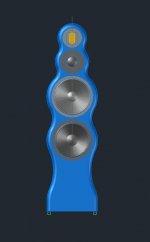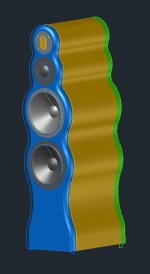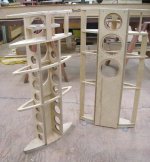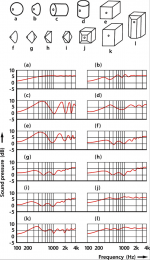Please educate me!
The questions is -
What are the benefits of minimising the baffle size (and rounding the edges) compared to a traditional flat, rectangular baffle? The assumption is that I would be using an active crossover/DSP so have free range (almost) on crossover order and frequency.
Context -
With the availability of CNC cutting and flexible wood products (Flexiply) it is possibly for DIYers to make fairly complex baffles and cabinets for sealed/BR traditional (no open baffle) speakers.
So, as an example I have attached a picture of a potential 3 way design with passive radiator (or double woofer) that could be made using CNC and flexiply. What would be the differences, compared to a traditional rectangular baffle, in terms of dispersion (i.e. off axis sound), soundstage and or instrument spacing (if any) or any other attribute (subjective or objective) of sound (understanding that driver chioice has a lot to do with it).
The questions is -
What are the benefits of minimising the baffle size (and rounding the edges) compared to a traditional flat, rectangular baffle? The assumption is that I would be using an active crossover/DSP so have free range (almost) on crossover order and frequency.
Context -
With the availability of CNC cutting and flexible wood products (Flexiply) it is possibly for DIYers to make fairly complex baffles and cabinets for sealed/BR traditional (no open baffle) speakers.
So, as an example I have attached a picture of a potential 3 way design with passive radiator (or double woofer) that could be made using CNC and flexiply. What would be the differences, compared to a traditional rectangular baffle, in terms of dispersion (i.e. off axis sound), soundstage and or instrument spacing (if any) or any other attribute (subjective or objective) of sound (understanding that driver chioice has a lot to do with it).
Attachments
When the baffle is minimal, the reflections will be strong (in this style). Maybe some will be close enough to the driver to benefit from precedence effect. The rounding you show is not much.
This has nothing to do with it.The assumption is that I would be using an active crossover
Last edited:
Generally just does bad things. Smaller baffle pushes up the baffle step frequency so the on axis sensitivity is lower over a larger range of frequencies. The drivers have to work harder to produce the same SPL -> more non-linear distortion.
Also for drivers like that dome midrange, because of the size of the faceplate, when you make a minimum size baffle it is going to approximate a circular baffle that is perhaps 3 times the diameter of the dome. This is very bad as it achieves near worse case baffle diffraction effects.
I recommend playing around with 'The edge' -> Tolvan Data
btw almost all baffles implement the 'precedence effect' because the effect covers the delay range of 5-40ms which is is 1.7meters to 13metres. Most people's baffles are smaller than that in every dimension. The science just tells us that we still hear sounds coming from the location of the drivers, but the frequency response is altered by the baffle.
Also for drivers like that dome midrange, because of the size of the faceplate, when you make a minimum size baffle it is going to approximate a circular baffle that is perhaps 3 times the diameter of the dome. This is very bad as it achieves near worse case baffle diffraction effects.
I recommend playing around with 'The edge' -> Tolvan Data
btw almost all baffles implement the 'precedence effect' because the effect covers the delay range of 5-40ms which is is 1.7meters to 13metres. Most people's baffles are smaller than that in every dimension. The science just tells us that we still hear sounds coming from the location of the drivers, but the frequency response is altered by the baffle.
Last edited:
I like this example from planet10. So is it a small baffle because it begins rounding back early, or a large one because it reaches wide?
Attachments
Uhmmm...I was thinking of that while waiting to the sleep to arrive, this night.
 Not related to this thread, but...
Not related to this thread, but...
Probably I saw some Dynaudio speaker disassembled and showed, in photograph. The speakers are well done, with aerodinamic basket and so on.
The baffle is minimal dictated by the slim tower design.
And I was asking to myself: is the design of the speaker done with the final utilization in mind or is it universal? For Dynaudio the answer is/might be different, as it produces its own speakers and makes the boxes and relative crossovers.
But, for a typical 2 way example ( ugly...) you can choose the parameters and you'll end up with the typical efficiency...I mean, the tweeter will be truncated in sensitivity by the mean of L-pad and the woofer will be crossed with a big inductor for the necessary BSC .
Looking at the measurements of the SS speakers meant to be used in 2 way speakers I see often the bump in response in the typical crossover region, which is said to be caused by the break-up but also by the raising response of the passband behavior of the trasducer, and I thought it to be benign since the SS speakers are well renowned so it mustn't be that bad.
This applies to every trasducer, of course.
I don't buy "the larger the better" conjecture as other findings.
BTW I never listened to a tower
 Not related to this thread, but...
Not related to this thread, but...Probably I saw some Dynaudio speaker disassembled and showed, in photograph. The speakers are well done, with aerodinamic basket and so on.
The baffle is minimal dictated by the slim tower design.
And I was asking to myself: is the design of the speaker done with the final utilization in mind or is it universal? For Dynaudio the answer is/might be different, as it produces its own speakers and makes the boxes and relative crossovers.
But, for a typical 2 way example ( ugly...) you can choose the parameters and you'll end up with the typical efficiency...I mean, the tweeter will be truncated in sensitivity by the mean of L-pad and the woofer will be crossed with a big inductor for the necessary BSC .
Looking at the measurements of the SS speakers meant to be used in 2 way speakers I see often the bump in response in the typical crossover region, which is said to be caused by the break-up but also by the raising response of the passband behavior of the trasducer, and I thought it to be benign since the SS speakers are well renowned so it mustn't be that bad.
This applies to every trasducer, of course.
I don't buy "the larger the better" conjecture as other findings.
BTW I never listened to a tower
Cabinet shape and frequency response
SE Electronics Munro Egg 150
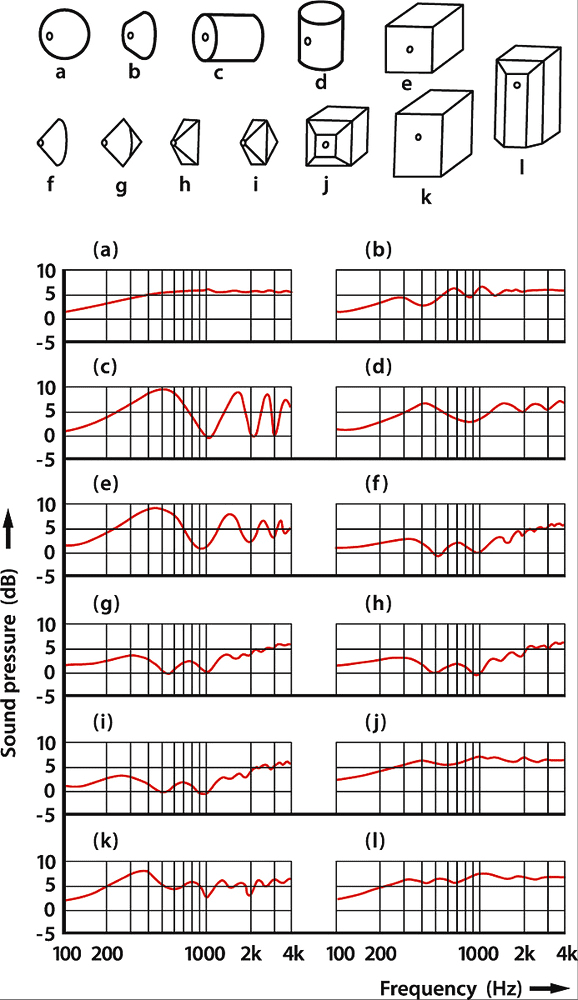
SE Electronics Munro Egg 150
Cabinet shape and frequency response: These graphs demonstrate the effect a loudspeaker's cabinet shape has on its frequency response.
Attachments
Benefit of a baffle as presented in the opening post, will most likely be in its aesthetics which may present to some a real advantage in comparison to traditionally looking baffles. Wealthy customers would probably rather purchase something odd looking even if acoustic performanse suffered under it, which may be irrelevant in the end anyway. If I were that curious, I'd build a test enclosure just like that and make the measurements.
I consider Planet 10's exemplar to be a wide-baffle design, and WB speakers beat all narrow baffle speakers I've ever heard. So would the Infinity RS series, or the Sonus Faber Stradivari, or the Troels Gravesen PMS:
Poor Man'
I particularly agree with this paragraph:
If I had to get engineering-like I'd say to pretend the speakers were open baffle and measure the distance to the rear of the driver. A minimum baffle design's distance is roughly the same as no baffle, while a wide baffle design's travel distance is multiples of the tweeter's own baffle.
Poor Man'
I particularly agree with this paragraph:
This speakers should have an Indian name and be called "Comes With a Room", because this is what wide baffled speakers o. They kind of bring in their own room. There's virtually no edge diffraction due to the wide baffle and the way these speakers recreate music in a room is special and to put it short: I like it! They can play strings, woodwinds and rock'n roll like few speakers of this size and from a 90 dB/2.8V sensitivity they do well with small amps. Read more about wide baffles and what they can do: [url]http://www.troelsgravesen.dk/Acapella_WB.htm[/URL]
If I had to get engineering-like I'd say to pretend the speakers were open baffle and measure the distance to the rear of the driver. A minimum baffle design's distance is roughly the same as no baffle, while a wide baffle design's travel distance is multiples of the tweeter's own baffle.
Last edited:
I don't fully realize what "image" or "imaging" does mean, but, yes, having a minimal baffle but /AND an aerodinamyc profile/form helps in making the box more invisible to the re-radiated sound. "image" being less blurry or with single light 
 just one shadow!
just one shadow!
Also same for radar and Stealth jet fighters...
Also same for radar and Stealth jet fighters...
I completely agree with this.I usually prefer speakers with a LARGE baffle and a lot of wood around drivers; they seem to be more "meaty" and effortless. My belief is that the skinny front baffle fashion is just to help with WAF; any claim of better sound I find very dubious.
I completely disagree with this.
As it was documented by vandersteen speakers, siegfried linkwitz (rip), john kreskovsky's nao note speakers and many others...including me.
I know very well that opinions on the narrow-versus-wide-baffle debate differ. Yet, in all that I have read, I can find little to nothing persuasive. I don't think I could list a single peer-reviewed article that sheds light on the question which ultimately comes down to a subjective preference for one diffracted spectrum over another. The answer to this open question may be a strong function of on-axis tuning, or room characteristics, or something else. What has been "documented" is, in my experience, somewhere between educated opinion (at best) and self-serving nonsense (typically).
And for the record, I probably qualify as an "expert":
AES Journal Forum >> Accurate Calculation of Radiation and Diffraction from Loudspeaker Enclosures at Low Frequency
With baffles there are some considerations to make:
1) chamfering the edges spreads out (in time) the soundreflection from the edges (as shown in the earlier graph),
2) unequal distance to edges (from the driver) spreads out the soundreflection and will affext the frequency curve less (if done right),
3) Baffle diffraction, The size of the baffle will determine what baffle support the bass will get from the baffle, the smaller baffle - the less support.
To test the planned baffles effect on the frequency curve there is a nice peice of software:
Home of the Edge
1) chamfering the edges spreads out (in time) the soundreflection from the edges (as shown in the earlier graph),
2) unequal distance to edges (from the driver) spreads out the soundreflection and will affext the frequency curve less (if done right),
3) Baffle diffraction, The size of the baffle will determine what baffle support the bass will get from the baffle, the smaller baffle - the less support.
To test the planned baffles effect on the frequency curve there is a nice peice of software:
Home of the Edge
How would a large baffle covered with felt, to mitigate edge diffraction, compare?
the damping properties of the felt are affected by the incoming angle of the sound wave, in this case it would have minor impact if any at all
I know very well that opinions on the narrow-versus-wide-baffle debate differ. Yet, in all that I have read, I can find little to nothing persuasive. I don't think I could list a single peer-reviewed article that sheds light on the question which ultimately comes down to a subjective preference for one diffracted spectrum over another. The answer to this open question may be a strong function of on-axis tuning, or room characteristics, or something else. What has been "documented" is, in my experience, somewhere between educated opinion (at best) and self-serving nonsense (typically).
And for the record, I probably qualify as an "expert":
AES Journal Forum >> Accurate Calculation of Radiation and Diffraction from Loudspeaker Enclosures at Low Frequency
Absence of evidence is not evidence of absence, as they say. What is the quality and quantity of evidence supporting the opposite take, ie:wide baffle better? Thanks for the insight and opinion, I find it fascinating.
- Status
- This old topic is closed. If you want to reopen this topic, contact a moderator using the "Report Post" button.
- Home
- Loudspeakers
- Multi-Way
- Benefits of minimal baffle
